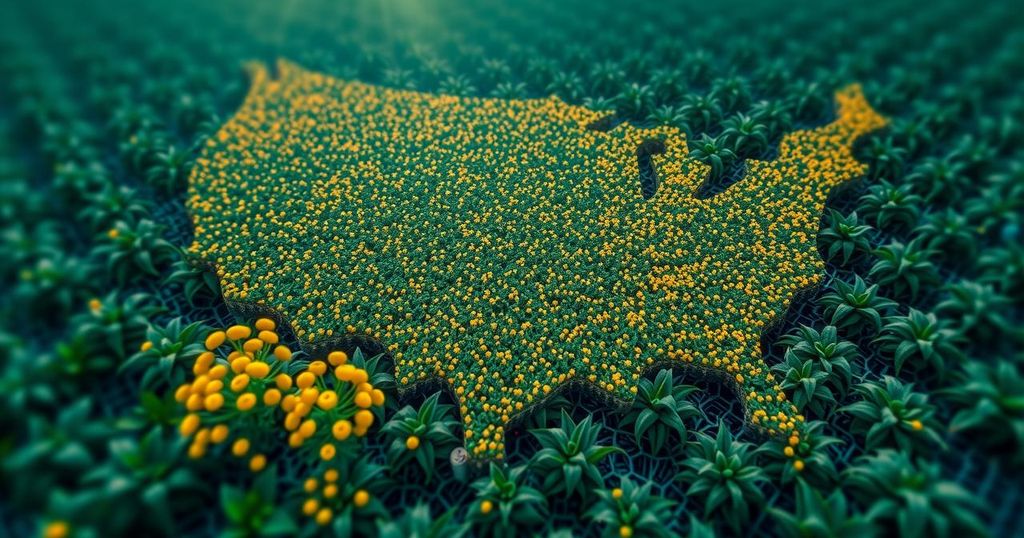AI
AGRICULTURE, AI INSTITUTE FOR NEXT GENERATION FOOD SYSTEMS, AMERICA, ARTIFICIAL INTELLIGENCE, BIDEN, BIOLOGICAL & AGRICULTURAL ENGINEERING, EARLES, FOOD INSECURITY, FOOD SECURITY, IL, ILIAS TAGKOPOULOS, INFLATION, MASON EARLES, NORTH AMERICA, OF VITICULTURE & ENOLOGY, UC DAVIS, UNITED STATES, USDA INSTITUTE OF FOOD AND AGRICULTURE
Amina Hassan
0 Comments
Harnessing Artificial Intelligence to Revolutionize U.S. Agriculture
The U.S. agriculture industry is embracing artificial intelligence to enhance productivity and combat rising labor shortages, with investments set to double by 2028. Experts at UC Davis are exploring innovative methods to optimize farm operations through data analysis and new technologies. AI’s potential in agriculture promises greater efficiency and sustainability, paving the way for a brighter future for farmers and consumers alike.
In the landscape of American agriculture, a striking transformation is unfolding. With a significant decline in the number of farms from 6.8 million in the 1930s to just about 1.9 million today, the average size has ballooned to 464 acres. Experts are now looking to harness the power of artificial intelligence (AI) to refine farming methods, enhancing productivity and efficiency while addressing increasing labor shortages, which have risen notably since 2014.
Mason Earles, a researcher at UC Davis, highlights the dual promise of AI: “There’s a lot of potential for both increasing productivity on the crop side, but also for reducing the amount of resources that we use on the productivity side.” The looming labor shortages, with 41% of farmers facing scarcity, create urgency to integrate technologies that can streamline processes and empower existing workers to achieve more with less.
At the AI Institute for Next Generation Food Systems, innovative strategies are being developed to improve agriculture through data collection and actionable insights. The USDA’s recent studies showed that only 27% of farmers currently utilize technologies like AI, but investment in this field is forecasted to more than double by 2028, an encouraging trend for future advancements.
“One of the big things… is trying to say, how can I make an impact in agriculture… across the board?” Earles continues, emphasizing the institute’s commitment to fostering collaboration between researchers, startups, and established corporations. AI systems can efficiently analyze vast amounts of data, leading to improved yields, better crop quality, and optimized use of resources, ultimately transforming the way farmers work.
As innovations unfold, the integration of AI hardware such as sensors and robotics is being explored to enhance data gathering. This technology allows farmers to make informed decisions regarding fertilizer application and harvest timings. Earles mentions, “There’s great examples out there of being able to process millions of images within the course of every hour to identify… damage due to weeds… or disease.”
Looking to the future, the dual goals of AI in agriculture are clear: boost productivity while encouraging sustainable practices. As the industry evolves, researchers are investigating revolutionary methods, like using virtual reality in poultry processing, with the aim of making these advanced technologies more accessible and cost-effective.
In parallel, controlled environments, such as indoor farming, are gaining traction despite their high initial costs, offering hope for higher yield crops less affected by weather fluctuations. Tagkopoulos states, “we see in the future more data being generated, more tools becoming available,” facilitating better irrigation and market strategies through shared data among farmers, ensuring that everyone benefits from collective advancement.
As funding aligns with innovative agricultural research, initiatives like the National Grape Improvement Center promise to unravel new possibilities. “AI has the real potential to help us understand how to regulate those types of indoor climates so that it can optimize the output,” adds Earles, pointing to a future where agriculture is not only more productive but also provides nourishing food to urban and underserved areas.
The American agriculture industry has undergone significant changes over the decades, shrinking in the number of farms while expanding in land size. As farmers face increasing challenges such as labor shortages and rising costs, experts are turning to artificial intelligence as a viable solution to enhance farming efficiency and productivity. The USDA is actively supporting research and development initiatives aimed at leveraging AI technologies to assist farmers in optimizing their operations.
The integration of artificial intelligence in agriculture promises to transform the industry, enabling farmers to enhance productivity while addressing labor shortages. The prospective growth in AI investments reflects an optimistic outlook for technological advancements that can streamline operations, improve crop quality, and ultimately provide sustainable solutions to modern farming challenges. As research continues, collaborative efforts among farmers, researchers, and technology providers pave the way for a future where agriculture can flourish in harmony with technological innovation.
Original Source: www.foxnews.com




Post Comment